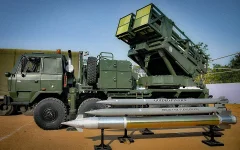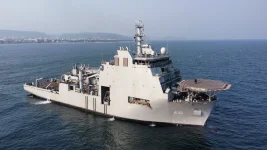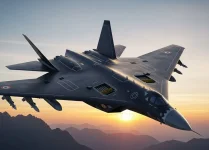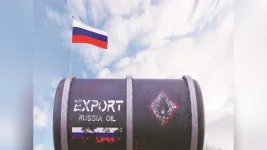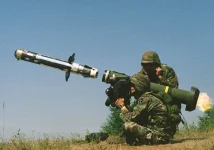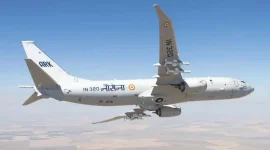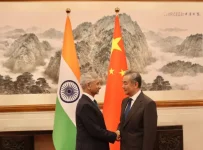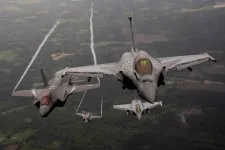- Views: 2K
- Replies: 51
The Indian Air Force (IAF) is at a critical juncture as it confronts a significant capability gap, operating with only 31 fighter squadrons against a sanctioned requirement of 42.
To counter emerging threats from neighbouring China and Pakistan, the acquisition of a fifth-generation stealth fighter has become a pressing priority.
At the recent Aero India 2025, two major international contenders were showcased: Russia’s Sukhoi Su-57E and the United States’ Lockheed Martin F-35A, each presenting a unique set of strategic opportunities and challenges for India.
The decision on which aircraft to procure involves a complex evaluation of operational needs, economic realities, geopolitical alignments, and the long-term future of India's indigenous defence industry.
The Case for Russia’s Sukhoi Su-57E
The Su-57E is the export model of Russia's premier stealth fighter, engineered for achieving air superiority and conducting multi-role missions. Its design emphasizes high manoeuvrability and is intended to integrate with India’s extensive inventory of Russian-made aircraft.Advantages
- Cost and Affordability: A primary argument for the Su-57E is its economic viability. With a projected unit price of approximately $35–40 million (₹2,953–3,384 crore), it is substantially more affordable than its American counterpart. Its lower operational expenses would allow the IAF to acquire a larger number of aircraft within its limited defence budget.
- Technology Transfer and Self-Reliance: Russia has made a significant proposal to provide full technology transfer, including the fighter's source code, enabling local production by Hindustan Aeronautics Limited (HAL). This aligns perfectly with India’s ‘Make in India’ initiative and would permit the integration of indigenous systems, such as advanced radars and the Astra series of missiles, promoting strategic autonomy.
- Fleet Compatibility: The IAF's fleet is dominated by over 250 Su-30MKI jets. Acquiring the Su-57E would create logistical synergy, simplifying maintenance, training, and the supply chain, as opposed to introducing an entirely new Western system.
- Performance and Manoeuvrability: Powered by twin engines with thrust-vectoring technology, the Su-57E boasts exceptional agility and a top speed of Mach 2, making it highly effective in dogfights and air superiority roles, a traditional strength of the IAF.
- Geopolitical Partnership: Russia has been a long-standing and reliable defence partner to India, generally avoiding the kind of sanctions that the U.S. could impose through laws like the Countering America's Adversaries Through Sanctions Act (CAATSA).
Disadvantages
- Stealth Capabilities: A major concern is that the Su-57E’s stealth features are considered less advanced than those of the F-35A. Design elements like its partially exposed engine nozzles result in a larger Radar Cross-Section (RCS), making it more detectable to modern air defence systems.
- Development and Reliability: The Su-57 program has been plagued by developmental delays and technical setbacks, including crashes of prototypes and early production models. With relatively few units produced, its overall reliability and maturity have not been proven to the extent of the F-35.
- Supply Chain Risks: The ongoing war in Ukraine and subsequent international sanctions have put Russia’s defence industry under severe strain. This could create future challenges regarding the availability of spare parts and critical upgrades for the aircraft.
- Impact on Indigenous Programmes: A major procurement of the Su-57E could divert vital funds and engineering focus from India's own fifth-generation fighter programme, the Advanced Medium Combat Aircraft (AMCA), potentially delaying India’s ambition for true self-reliance in combat aviation.
The Case for the United States’ F-35A Lightning II
The F-35A is the world’s most widely used fifth-generation fighter, celebrated for its advanced stealth, sensor fusion, and network-centric operational capabilities. An offer to sell the aircraft to India was reportedly made by the U.S. in 2025, representing a technological leap for the IAF.Advantages
- Superior Stealth and Situational Awareness: The F-35A’s design incorporates Very Low Observable (VLO) stealth technology and an internal weapons bay, making it extremely difficult for enemy radar to detect. Its advanced sensor suite, including a 360-degree view for the pilot, is designed to penetrate heavily defended airspace and counter advanced threats like China’s J-20 fighter.
- Combat-Proven Record: With over 1,000 aircraft delivered and operational experience with multiple air forces, including Israel and NATO allies, the F-35 is a mature and low-risk platform. Its robust global supply chain and support network are well-established.
- Interoperability with Allies: Acquiring the F-35 would greatly improve India’s operational compatibility with key partners in the Quad alliance (U.S., Japan, and Australia), which is crucial for India’s strategy in the Indo-Pacific region.
- Countering Regional Threats: The aircraft's advanced capabilities are seen as a direct answer to the growing stealth fighter fleets of China (J-20 and J-35A) and Pakistan’s planned acquisition of the J-35.
Disadvantages
- Exorbitant Cost: The F-35A’s high price tag, estimated at $80–100 million (₹6,750 crore) per unit, and its staggering operational cost of around $44,000 per flight hour, would place immense strain on India's defence budget and limit the number of aircraft that could be purchased.
- Single-Engine Design: The IAF has historically shown a preference for twin-engine fighters for enhanced safety and survivability over India's vast and diverse terrain. The F-35A's single-engine configuration is a significant operational concern.
- Restricted Technology Access: U.S. export laws would severely limit technology transfer. India would be unable to access the F-35’s source code or freely integrate its own weapons and systems, undermining the goal of strategic independence.
- Logistical Complexity and Geopolitical Conditions: Introducing the F-35A would complicate the IAF's logistics, which already supports seven different types of combat aircraft. Furthermore, U.S. arms deals often come with conditions that could require India to abandon other defence partnerships, such as its S-400 missile system deal with Russia.
A Strategic Crossroads for India
The choice between the Su-57E and the F-35A is not just a technical one but a decision that will shape India's strategic direction for decades.The Su-57E offers an affordable path to fleet modernization that aligns with India's industrial policy, while the F-35A provides a combat-proven technological edge and deeper integration with Western allies.
This decision is further complicated by the need to fund other critical projects, including the Multi-Role Fighter Aircraft (MRFA) tender for 114 new jets and, most importantly, India’s indigenous AMCA programme.
The AMCA, approved with a ₹15,000-crore budget, is the cornerstone of India’s long-term air power strategy but is not expected to enter service until 2035. Any major foreign purchase must serve as a stopgap without derailing this vital national project.
Ultimately, New Delhi must balance its immediate security needs against its long-term vision for self-reliance and its place in a shifting global order.

